 |
 |
 |
| |
Fosamprenavir or Atazanavir Boosted with Ritonavir Given Once Daily with Tenofovir /Emtricitabine in Antiretroviral Naive HIV-Infected Patients: ALERT Study Virology Analysis Through 48 Weeks
|
| |
| |
Reported by Jules Levin, Monday
ICAAC Sept 17-20, 2007
K. Smith1, W. Weinberg2, E. DeJesus3, M. Fischl4, Q. Liao5, K. Pappa5, T. Lancaster5, L. Ross5
1Rush University Medical Center, Chicago, United States, 2Kaiser Permanente, Atlanta, United States, 3Orlando Immunology Center, Orlando, United States, 4University of Miami, Miami, United States, 5GlaxoSmithKline,Research Triangle Park, United States
"....Comparable virologic suppression was observed in both once daily regimens through 48 weeks.....three of the four subjects with viral failure in the fosamprenavir arm suggests that HIV isolated from these subjects contained drug resistance mutations prior to the start of their antiviral therapy ...minority variants containing resistance mutations may be impacting virologic response.... Clonal analysis is ongoing for samples from all seven subjects with VF to better understand the impact of these low abundance variants and these results will be reported at a future meeting...."
GSK is the first company to consider the possibility of low-level genotypic mutations may have existed but undetected by standard genotype testing, and this might have caused viral failure. This is in the wake of reports at the Resistance Workshop Summer 2007 where a study was reported finding low-level genotype resistance undetected by standard genotype detected by 'ultra-deep sequencing'. Several studies find these low-level genotype mutations may cause viral failure. As of now there is no access to such low-level genotypic resistance testing for patients. There is some controversy regarding the clinical significance of the mutations but several studies including from the CDC found them associated with viral failure.
INTRODUCTION
The resistance profile of ART-naive patients experiencing virologic failure (VF) on a once-daily regimen of 300 mg/200 mg tenofovir/emtricitabine (TDF/FTC) plus either 1400 mg fosamprenavir + 100 mg ritonavir (FPV/r) or 300 mg atazanavir+ 100 mg ritonavir (ATV/r) was examined in a 48 week open-label, randomized study.
METHODS
Plasma HIV samples were analyzed by population genotype and phenotype at sequential timepoints, including at baseline and at virologic failure (VF) through 48 weeks (Monogram BioSciences) from the patients experiencing virologic failure. Clade assignment was as given in the Monogram PhenoSense GT report.
Virologic failure was defined as confirmed HIV-1 RNA ≥400 copies/mL at ≥24 weeks or rebounding >400 copies/mL after viral suppression.
Resistance mutations shown are as per the current IAS-USA Drug Resistance Mutations group guidelines (http://www.iasusa.org), and mutations considered thymidine analogue mutation (TAM) reversions.
RESULTS
106 patients enrolled (53 per arm). The baseline characteristics of subjects enrolled in each study arm are shown in Table 1.
At Wk 48, by ITT observed analysis, 93% (42/45) on the FPV/r arm vs 96% (46/48) on the ATV/r arm achieved VL<400c/mL and 89% (40/45) on the FPV/r arm vs 92% (44/48) on the ATV/r arm achieved VL<50c/mL.1
A total of seven subjects met VF criteria through 48 weeks. Four patients met VF criteria on the FPV/r arm and three patients met VF criteria on ATV/r arm. Six of these seven subjects had Clade B HIV (one had Clade G virus).
The genotypic and phenotypic profiles for subjects with VF on the FPV/r arm are shown in Figure 1, while the genotypic and phenotypic profiles for subjects with VF on the ATV/r arm are shown in Figure 2.
DISCUSSION
Transmission of drug resistant HIV has been increasing in United States. Recently the DHHS guidelines were updated to recommended genotyping
antiviral-naive subjects prior to antiviral treatment initiation.2
The resistance profiles at baseline and at failure, in conjunction with the baseline drug susceptibility data from three of the four subjects with VF in the FPV arm suggests that HIV isolated from these subjects contained drug resistance mutations prior to the start of their antiviral therapy. However, only one subject (Subject FPV/r 1) had major RT and PI drug resistance associated mutations detectable by conventional population sequencing.
VF's in the ATV arm had reduced susceptibility to ATV or a >2X rise in ATV FC detected in the absence of detection of major PI mutations. This suggests that minority variants containing resistance mutations may be impacting virologic response.
Clonal analysis is ongoing for samples from all seven subjects with VF to better understand the impact of these low abundance variants and these results will be reported at a future meeting.
CONCLUSIONS
Comparable virologic suppression was observed in both once daily regimens through 48 weeks.
Despite pre-existing resistance (detected by genotype or phenotype or both) to FPV or TDF/FTC in three patients randomized to the FPV/r arm, similar numbers of patients experienced VF on both arms.
While the presence of pre-existing drug resistance was detected in patients with VF on the FPV/r arm using population genotype and phenotype, it cannot be ruled out that low abundance variants may have impacted virologic response in both treatment arms. Clonal analysis to address this question is ongoing.

Figure 1. Longitudinal Population Genotypic and Phenotypic Changes for Subjects with Virologic Failure Treated with tenofovir/emtricitabine +fosamprenavir +100 mg ritonavir . Major mutations and fold change in IC50 above cut-off are shown in red.
FPV/r arm:
Subject FPV/r-1:
--Baseline TAM, TAM reversion mutations, plus major protease mutations
with reduced susceptibility (RS) to FPV and other PI's.
--VF at Week 12- additional RT and protease mutations selected at Week 12
and at Week 28. Week 28- virus acquired RS to FTC and to FPV.
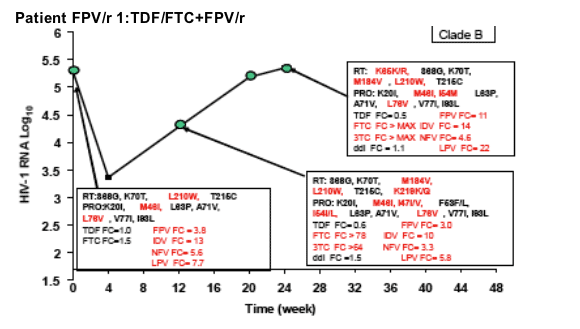
Subject FPV/r-2:
--Baseline- no detectable major resistance-associated mutations.
--VF- M184V, TAMs and TAM reversion mutations, and RS to all NRTIs. Since TDF is not known to select for M41L, L210W, and T215Y, it is possible these mutations were reselected from archived drug-resistant HIV
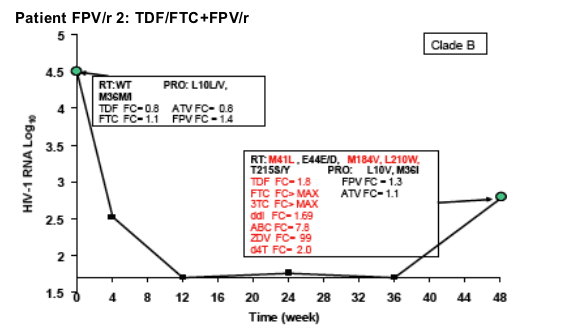
Subject FPV/r-3 (Clade G):
--Baseline- no detectable major resistance-associated mutations, but RS to FPV
--VF- M184V and RS to FTC was detected, plus major PI mutations and RS to FPV, lopinavir (LPV), nelfinavir (NFV) and saquinavir (SQV).
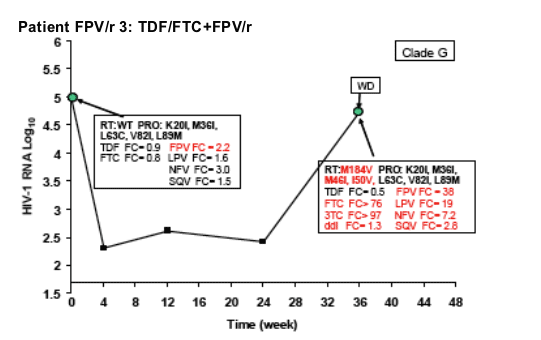
Subject FPV/r-4:
--Baseline- no detectable major resistance-associated mutations or RS.
--Week 12-a mixture of K65K/R detected.
--Week 24- the K65R detected, plus the M46M/I and I47V PI mutations, and RS
to all study drugs.
--Week 32- additional selection of RT D67N mutation also detected.

ATV/r arm
Subject ATV/r-1:
--Baseline- no detectable major resistance-associated mutations
--VF- a M184M/V mixture detected along with RS to FTC and 3TC
Subject ATV/r-2:
--Baseline and VF- no detectable major resistance-associated mutations.
--VF confirmation- no resistance mutations detected, but RS to ATV plus
indinavir (IDV), SQV and tipranavir (TPV) observed
Subject ATV/r-3:
--Baseline and VF - no detectable major resistance-associated mutations. RS to study drug was not observed. However, the FC for ATV increased from 0.9 at baseline to 2.1 at VF (FC cutoff for ATV RS is 2.2).
Figure 2. Longitudinal Population Genotypic and Phenotypic Changes for Subjects with Virologic Failure Treated with tenofovir/ emtricitabine +atazanavir +100 mg ritonavir. Major mutations and fold change in IC50
above cut-off are shown in red.
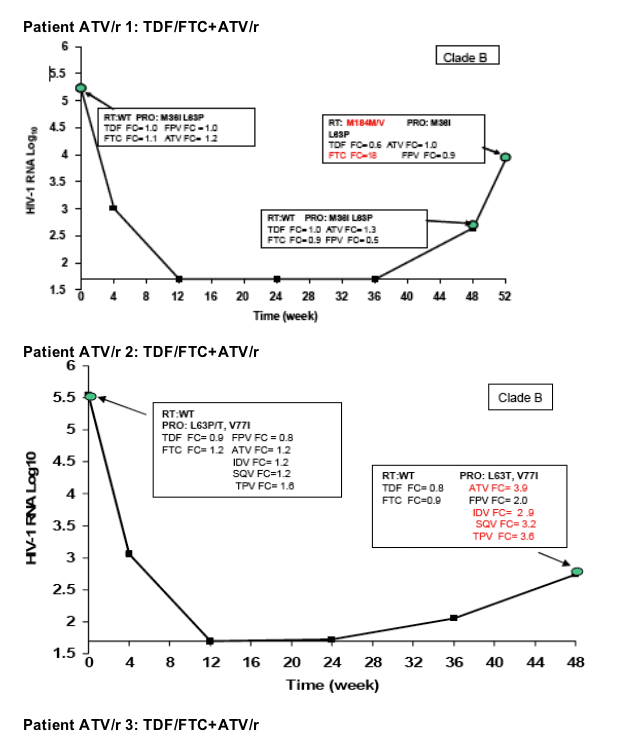
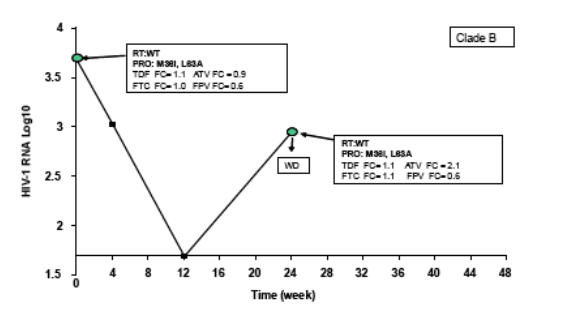
References
1. Smith K. et al. 2007 IAS, Sydney, AU Abstract WEPEB023.
2. DHHS Panel on Antiretroviral Guidelines for Adults and Adolescents. Guidelines for the Use of Antiretroviral Agents in HIV-1-Infected Adults and Adolescents. May 4, 2006 http://AIDSinfo.nih.gov
|
| |
|
 |
 |
|
|